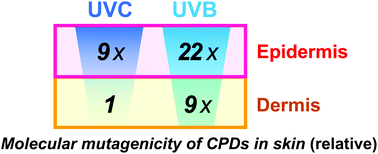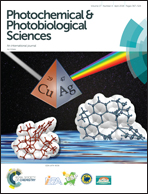Quantitative analysis of UV photolesions suggests that cyclobutane pyrimidine dimers produced in mouse skin by UVB are more mutagenic than those produced by UVC
Abstract
The amount of photolesions produced in DNA after exposure to physiological doses of ultraviolet radiation (UVR) can be estimated with high sensitivity and at low cost through an immunological assay, ELISA, which, however, provides only a relative estimate that cannot be used for comparisons between different photolesions such as cyclobutane pyrimidine dimer (CPD) and pyrimidine(6-4)pyrimidone photoproduct (64PP) or for analysis of the genotoxicity of photolesions on a molecular basis. To solve this drawback of ELISA, we introduced a set of UVR-exposed, calibration DNA whose photolesion amounts were predetermined and estimated the absolute molecular amounts of CPDs and 64PPs produced in mouse skin exposed to UVC and UVB. We confirmed previously reported observations that UVC induced more photolesions in the skin than UVB at the same dose, and that both types of UVR produced more CPDs than 64PPs. The UVR protection abilities of the cornified and epidermal layers for the lower tissues were also evaluated quantitatively. We noticed that the values of absorbance obtained in ELISA were not always proportional to the molecular amounts of the lesion, especially for CPD, cautioning against the direct use of ELISA absorbance data for estimation of the photolesion amounts. We further estimated the mutagenicity of a CPD produced by UVC and UVB in the epidermis and dermis using the mutation data from our previous studies with mouse skin and found that CPDs produced in the epidermis by UVB were more than two-fold mutagenic than those by UVC, which suggests that the properties of CPDs produced by UVC and UVB might be different. The difference may originate from the wavelength-dependent methyl CpG preference of CPD formation. In addition, the mutagenicity of CPDs in the dermis was lower than that in the epidermis irrespective of the UVR source, suggesting a higher efficiency in the dermis to reduce the genotoxicity of CPDs produced within it. We also estimated the minimum amount of photolesions required to induce the mutation induction suppression (MIS) response in the epidermis to be around 15 64PPs or 100 CPDs per million bases in DNA as the mean estimate from UVC and UVB-induced MIS.



 Please wait while we load your content...
Please wait while we load your content...